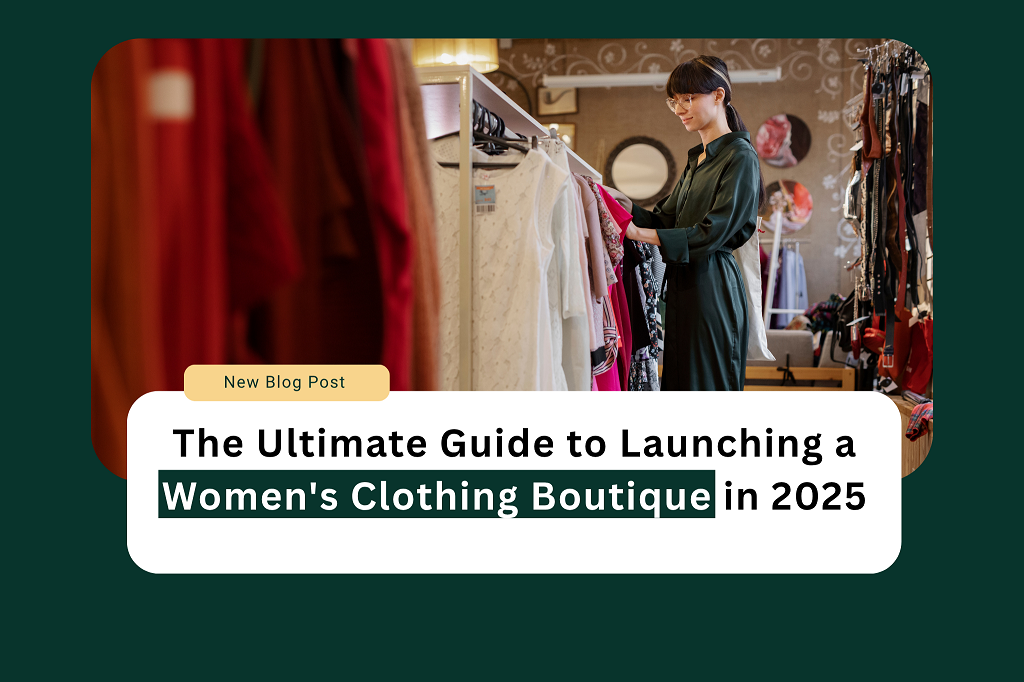Introduction
Building a women’s clothing boutique involves more than just selling designs; it also entails creating a destination for fashion-forward consumers. The current retail market gives boutique owners new possibilities for integrating traditional retail storefronts with digital business techniques. The women’s clothing boutique industry maintains a substantial market worth of $41.1 billion in the United States, as reported by IBISWorld. This complete tutorial provides all the necessary knowledge to turn your fashion retail aspirations into an established business operation.
Understanding Your Market Niche
A boutique business requires successful identification of its distinctive market role, followed by complete market leadership. Boutiques that serve particular consumer segments, such as sustainable fashion and size-inclusive clothing, obtain a 23% increase in customer retention compared to regular retail outlets, according to research conducted by the National Retail Federation. The market success of your boutique depends on examining your local customer base combined with analyzing competing stores and studying upcoming trends in the fashion industry.
Your target audience consists of young professionals who need work attire, eco-minded consumers, or high-end shoppers. The selection of your specialty market determines every aspect of your business, including pricing decisions and visual appearance. Among the many retail competitors, you can be identified by your unique customers.
Creating Your Brand Identity
The brand identity of your boutique must present an attractive narrative that appeals to your intended customer group. The store’s identity includes its name, logo elements, color choices, and visual design aspects. According to findings published by Retail Dive, boutiques build successful customer engagement by developing strong brand identities, which leads to a 31% boost. The visual elements of your brand should appear in each touchpoint, including shopping bags as well as social media platforms.Professional designers should help you develop unified branding elements. At its core, your brand needs more than visual aspects because it fosters emotional responses from those who encounter your boutique.
Financial Planning and Budgeting
Your boutique’s achievement depends heavily on a stable financial basis. The initial investment costs between $50,000 to $150,000 to cover expenses that include inventory purchase and store fixtures and working capital needs. A Small Business Administration report shows that profitable fashion retailers should achieve minimum gross margins of 55%. Develop complete financial projections that specify startup expenditures and ongoing business expenses together with revenue prediction projections.
Business owners should evaluate both seasonal market patterns together with inventory speed of movement. The business needs to obtain sufficient funding from savings and loans and investor capital alongside maintaining cash reserves to handle unforeseen costs. Factor into your budget all costs related to technology maintenance as well as marketing investments and staff instruction expenses.
Location Strategy
The right location stands as a crucial factor that determines whether your boutique will succeed or fail. Industry experts suggest businesses should study how many people walk by their location, check how much parking they have available and measure their distance from related businesses. High-traffic areas combined with good storefront visibility lead boutiques to achieve 40% more revenue than shops located in lower-traffic areas.
Check the lease terms together with renovation expenses and examine local zoning rules. The retail storefront must be situated where your main customers conduct their shopping so you can maximize your sales potential. Review all lease costs and negotiate beneficial terms that include utility bills and maintenance expenses while understanding probable rental rate growth.
Inventory Management
Keeping a smart inventory system is vital to maintain positive cash flow levels and generate optimum profits. Businesses must implement a sophisticated inventory tracking system that provides both sales pattern data and stock inventory levels. Fashion industry research shows that boutiques employing advanced inventory monitoring systems lower their inventory costs by 25%. Building strong business relationships with several suppliers will provide both consistent inventory supplies and favorable prices.
Your product purchases should follow seasonal patterns and match local event timings. Businesses should evaluate minimum order requirements together with payment conditions and return procedures when selecting suppliers. Your store should contain a strategic balance between foundation pieces and trend items that address varied customer tastes.
Marketing and Digital Presence
A powerful digital profile has become an absolute necessity for businesses in the present digital era. According to the Fashion Retail Academy, a boutique can achieve higher customer retention rates when maintaining active social media engagement which leads to 32% increased customer loyalty. The merchant needs to develop an extensive marketing plan that includes social media platforms alongside email campaigns together with local area promotional methods.
Your merchandise should appear through fascinating content that also expresses your branding narrative. High-quality product images should be part of your investment alongside collaboration with influencers. Start an email subscription system for tailored promotions alongside customer contact methods. Measure your marketing metrics because this data will show which promotional approaches work best for your boutique.
Customer Service Excellence
Outstanding customer service enables boutiques to differentiate themselves from rival businesses. Your staff needs training to master product information as well as styling abilities and personalized customer service approaches. Organizations that develop expert customer support personnel reach 45% greater revenue performance based on their available floor space.
A customer relationship management system should be implemented to monitor customer preferences together with purchase records. Establish an environment that welcomes customers to return regularly. Provide personal styling along with exclusive shopping events as benefits exclusively for loyal customers. Customer recommendations based on satisfaction hold immense value for developing your business.
Conclusion
Establishing a women’s clothing boutique demands strategic preparation together with market knowledge and absolute devotion to high-quality service. When you use this detailed guide as your guide while keeping an eye on market changes you establish excellent conditions for operating a successful fashion business. Learning continuously alongside being adaptable will lead to lasting achievements in today’s dynamic retail sector.
We’d love to hear your thoughts on this guide! Are you planning to open a boutique? Share your experiences and questions in the comments below, and don’t forget to share this article with other aspiring fashion entrepreneurs on your social media networks.
FAQs
What amount of funding would be necessary to establish a women’s clothing boutique?
A startup investment for a women’s clothing boutique requires between $50,000 and $150,000. The initial investment for starting a women’s clothing boutique requires funds between $20,000 to $40,000 for inventory, $10,000 to $25,000 for store fixtures, $5,000 to $15,000 for lease deposit and first month’s rent, $2,000 to $5,000 for technology, and $3,000 to $8,000 for marketing.
Which profit margins should be my expectation?
The gross margin average for most boutiques falls between 55% and 70%. Boutiques selling luxury items reach 80% gross margin, whereas stores focused on affordable fashion reach 45-55%. To achieve success after expense deductions, maintain a net profit margin between 8% and 10%.
What specific combination of products should I choose for my store?
A boutique should maintain 70% classic merchandise and 30% items based on current fashion trends. Your business should carry various price levels that fall within your target pricing area. Your inventory contains two primary sales drivers where 80% of sales result from 20% of your items.
What fundamental technologies will I require?
The essential technology needs comprise a POS system with inventory management and an e-commerce platform alongside a CRM system and social media management tools. A retailer needs to allocate $2,000-$6,000 for their setup expenses and $200-$800 annually for subscription services.
What strategies should I use to compete against bigger retailers?
The establishment of personalized service combined with outstanding customer service. Your business needs to provide styling assistance in addition to distinctive events and local community development. It must connect online marketing with exclusive store-based interactions.








